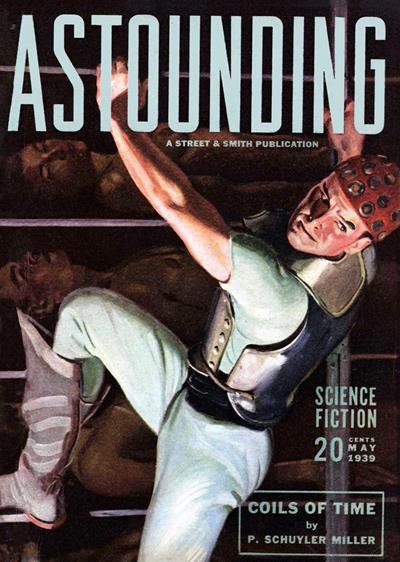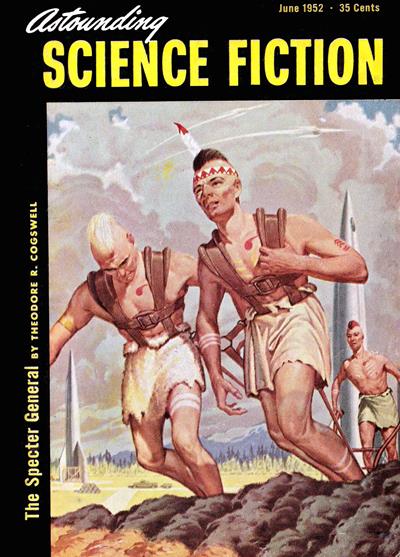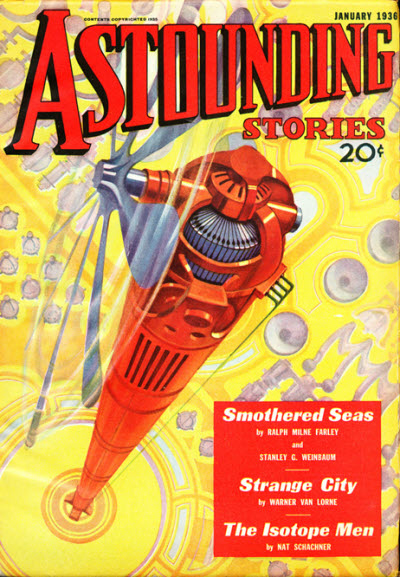
Part of Series
Vol 23, No 3. Contents: • Those Marvelous Inventions • [Editorial (Astounding)] • essay by John W. Campbell, Jr. [as by The Editor] 9 • Coils of Time • [Sands of Time • 2] • novelette by P. Schuyler Miller 37 • Laboratories Aren't Playful • essay by John W. Campbell, Jr. [as by Arthur McCann] 38 • Fire-Maker • essay by John W. Campbell, Jr. [as by Arthur McCann] 39 • The Day Is Done • short story by Lester del Rey 50 • No Other Race • essay by uncredited 51 • Special Flight • novelette by John Berryman 79 • Employment • short story by L. Sprague de Camp [as by Lyman R. Lyon] 92 • In Times to Come (Astounding, May 1939) • [In Times to Come (Astounding)] • essay by The Editor 92 • The Analytical Laboratory: March 1939 (Astounding, May 1939) • [The Analytical Laboratory] • essay by uncredited 93 • Melody and Moons • [Pvt. Kelton] • short story by Kent Casey 103 • Design for Life (Part 1 of 2) • essay by L. Sprague de Camp 117 • One Against the Legion (Part 2 of 3) • [Legion of Space • 3] • serial by Jack Williamson 152 • Science Discussions and Brass Tacks (Astounding, May 1939) • [Brass Tacks] • essay by The Editor 152 • Letters. 【 PREVIOUS ISSUE ← May 1939 → NEXT ISSUE 】
Authors


Peter Schuyler Miller (February 21, 1912 – October 13, 1974) was an American science fiction writer and critic. Miller was raised in New York's Mohawk Valley, which led to a lifelong interest in the Iroquois Indians. He pursued this as an amateur archaeologist and a member of the New York State Archaeological Association. He received his M.S. in chemistry from Union College in Schenectady. He subsequently worked as a technical writer for General Electric in the 1940s, and for the Fisher Scientific Company in Pittsburgh from 1952 until his death. Miller died October 13, 1974 on Blennerhassett Island, West Virginia. He was on an archaeological tour to the "Fort Ancient culture" site west of Parkersburg at the time. Miller wrote pulp science fiction beginning in the 1930s, and is considered one of the more popular authors of the period. His work appeared in such magazines as Amazing Stories, Astounding, Comet, The Magazine of Fantasy and Science Fiction, Marvel Tales, Science Fiction Digest, Super Science Stories, Unknown, Weird Tales, and Wonder Stories, among others. An active fan of others' work as well as an author, he is also known as an early bibliographer of Robert E. Howard's "Conan" stories in the 1930s, together with his friend John D. Clark. Miller gradually shifted into book reviewing beginning in 1945, initially for Astounding Science Fiction and later for its successor, Analog. He began a regularly monthly review column in the former in October, 1951. As a critic he was notable for his enthusiasm for a wide coverage of the science fiction field. He was awarded a special Hugo Award for book reviews in 1963. His extensive collection of papers, maps, books and periodicals, accumulated largely as a result of his review work, was donated to the Carnegie Museum after his death by his sister Mary E. Drake. They now form the basis of the P. Schuyler Miller Memorial Library at the Edward O'Neill Research Center in Pittsburgh.

Lester del Rey was an American science fiction author and editor. Del Rey is especially famous for his juvenile novels such as those which are part of the Winston Science Fiction series, and for Del Rey Books, the fantasy and science fiction branch of Ballantine Books edited by Lester del Rey and his fourth wife Judy-Lynn del Rey. Also published as: Philip St. John Eric van Lihn Erik van Lhin Kenneth Wright Edson McCann (with Frederik Pohl)

John Allyn Berryman (originally John Allyn Smith) was an American poet, born in McAlester, Oklahoma. He was a major figure in American poetry in the second half of the 20th century and often considered one of the founders of the Confessional school of poetry. He was the author of The Dream Songs, which are playful, witty, and morbid. Berryman committed suicide in 1972. A pamphlet entitled Poems was published in 1942 and his first proper book, The Dispossessed, appeared six years later. Of his youthful self he said, 'I didn't want to be like Yeats; I wanted to be Yeats.' His first major work, in which he began to develop his own unique style of writing, was Homage to Mistress Bradstreet, which appeared in Partisan Review in 1953 and was published as a book in 1956. Another pamphle. His thought made pockets & the plane buckt, followed. It was the collection called Dream Songs that earned him the most admiration. The first volume, entitled 77 Dream Songs, was published in 1964 and won the Pulitzer Prize for poetry. The second volume, entitled His Toy, His Dream, His Rest, appeared in 1968. The two volumes were combined as The Dream Songs in 1969. By that time Berryman, though not a "popular" poet, was well established as an important force in the literary world, and he was widely read among his contemporaries. In 1970 he published the drastically different Love & Fame. It received many negative reviews, along with a little praise, most notably from Saul Bellow and John Bailey. Despite its negative reception, its colloquial style and sexual forthrightness have influenced many younger poets, especially from Britain and Ireland. Delusions Etc., his bleak final collection, which he prepared for printing but did not live to see appear, continues in a similar vein. Another book of poems, Henry's Fate, culled from Berryman's manuscripts, appeared posthumously, as did a book of essays, The Freedom of the Poet, and some drafts of a novel, Recovery. The poems that form Dream Songs involve a character who is by turns the narrator and the person addressed by a narrator. Because readers assumed that these voices were the poet speaking directly of himself, Berryman's poetry was considered part of the Confessional poetry movement. Berryman, however, scorned the idea that he was a Confessional poet.


